The Heat Is Not On
Furnace troubleshooting
The heater fan won't turn on; the heater is dead
First, check the 12V power--do the ceiling lights work? Does the patio light work? If not, the problem may lie with the battery or converter and not necessarily the heater. If the lights do work but the heater is not getting power check the heater fuse (remove the heater faceplate/grate (by removing the two screws that hold the grate to the heater) and look for a red wire with a fuse holder in-line--check the fuse in the fuse holder).
Second, if you know the heater is getting power but still won't turn on, check the thermostat. Sometimes the slider that turns the heater off pushes the power contact clock-wise away from it's correct position (instead of pushing the contact up and away from it's "on" position"). In this case the heater turns off as expected but the next time you try to turn the heater on, nothing happens.
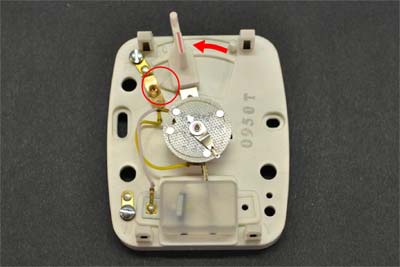
The white triangular plastic (attached to the control slider) is touching the metal contact that turns the furnace on.
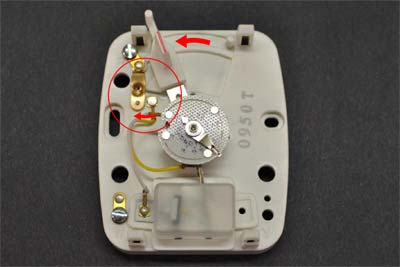
The slider rotated the metal contact away from its position.
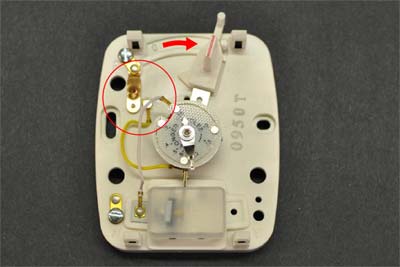
The next time the slider is turned to the "on" position the thermostat will look like it's on but the metal arm cannot make contact and no power will be sent to the heater.
If the contact has rotated out of position simply push the contact counter-clock-wise until it touches the round contact spot on the base of the thermostat. To prevent this from happening again, push towards the back of the thermostat slightly the next time you slide the control to "off."
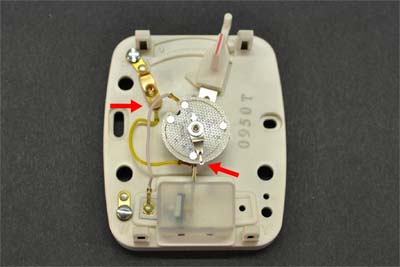
This is what the thermostat should look like when the slide control is turned to "on." The metal arm makes contact with the lower receiver and the cycle adjustment is touching the wire (this point is covered in the next paragraph).
Third, the cycle adjustment might not be touching the wire. The thermostat cycle adjustment has a "dead zone" where there is no wire. If the adjustment arm has vibrated off the wire the thermostat will not turn the furnace on. Rotate the adjustment arm until it touches the wire.
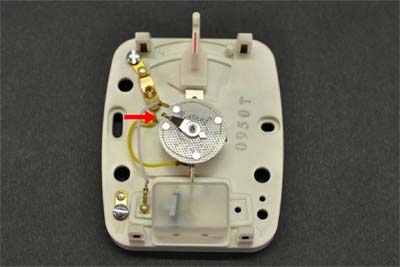
The cycle adjustment (the metal piece that looks like an arrow) has slipped off the wire and is not making contact with the wire anywhere.
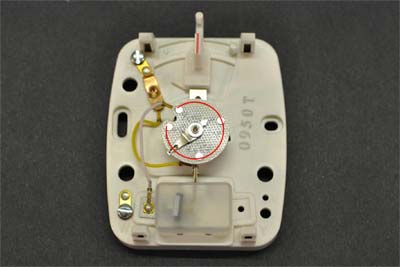
The cycle adjustment arm (arrow) must be touching the wire (as shown by the red line).
Lastly, to double-check if the thermostat is indeed the problem remove the two brown wires that attach to the thermostat (from the furnace) and connect the two wires together directly. If the furnace operates normally you'll know the thermostat is the issue. If the heater doesn't turn on the heater may have a blown fuse.
The heater fan turns on for about 30 seconds and then shuts off.
This is probably a sail-switch issue. The sail-switch is a safety device that turns off the propane if the furnace loses 12V power (no 12V power = no fan = no way for the furnace to cool itself off, so the gas still burning in a furnace that has lost power could be a dangerous situation, hence the sail-switch).
For 17,000 BTU furnaces (and the occasional 19,000 BTU furnace):
Two situations may cause the sail-switch to not move into its proper position and not allow the furnace to ignite:
Low battery: if the battery is too low to spin the heater fan at the proper speed, the air blowing on the switch is too slow to push the sail-switch into position.
In this case getting more power to the heater (by running a generator, hooking up a new battery, or hooking up a car and charging the battery through a hot lead or jumper cables) will speed up the fan and allow it to push the switch into place.
High altitude: the higher the campsite, the thinner the air. If the air is too thin the heater fan can be running at top speed and still not have enough air to push the sail-switch into proper position.
The heater grate restricts the airflow around the heater. By removing the two screws that hold the grate in place and removing the grate itself, more air can move to the back of the furnace; the increased volume of air may be enough to overcome the high altitude issue.
![]() Removing the heater grate is a temporary solution. For our thoughts regarding a more permanent solution please call us at 303-922-6221.
Removing the heater grate is a temporary solution. For our thoughts regarding a more permanent solution please call us at 303-922-6221.
For 19,000 BTU furnaces (if it's not a low battery or high altitude):
The sail switch may not be fully engaged. The switch appears to move into it's proper position but the plastic housing of the switch itself sometimes prevents the switch from closing the circuit properly.
We're sorry we can't put our thoughts regarding this issue online but please call us at 303-922-6221 for assistance.
High-limit switch
An uncommon issue with the same symptom is a bad high-limit switch. This is a fail-safe device that cuts power to the heater if the temperature of the burner exceeds a set limit. Once a limit-switch has been "sprung" by high heat it returns to it's "on" position once it cools down. However, in some cases the switch simply breaks (and not necessarily from heat) and needs to be replaced.
The heater fan turns on and I hear a clicking sound, but the propane never lights.
Check that you have propane. Light the stove and make sure the flame is burning at the normal strength. If not, there may be an obstruction in the propane line or the regulator or hose that runs to the propane tank may have a problem.
If the camper has not been used for a while the gas line may have no propane in it. The clicking sound is the heater's igniter trying to light the gas. As the heater is trying to light the gas, air in the gas line is bled out. Once the propane arrives the furnace should light.
In some cases the gas line is too long for the heater to bleed out all of the air in one attempt. After two attempts to light the furnace (two rounds of clicking sounds) if the gas has not arrived yet the furnace will turn itself off (as a safety measure). Turn the furnace off (using the thermostat) and back on, this will give the furnace two more attempts to light the propane.
In some campers the furnace is located at the rear of the camper and the gas line almost always requires a second on/off cycle to light the propane (unless the stove or fridge was lit prior to trying the furnace). We know of no pop-up camper that requires a third on/off cycle.
If the furnace doesn't light after two cycles, there may be a more serious problem such as a broken igniter, a clogged burner, or a bad control board. These problems are difficult to trouble-shoot online or even over the phone; bringing the furnace in for a bench test is the better solution at that point (sorry!).
![]() Back to Troubleshooting
Back to Troubleshooting
Privacy © 2009-2025 Roberts Sales. All rights reserved.

